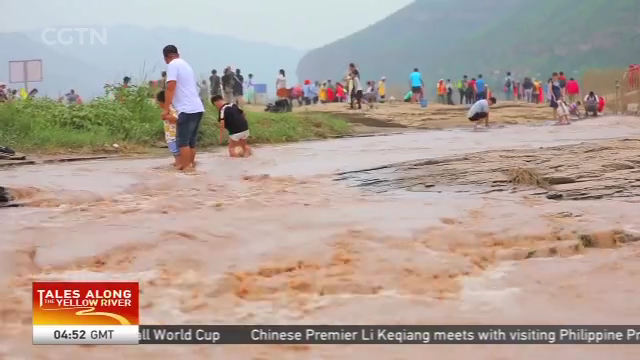
13:20, 31-Aug-2019
Tales Along the Yellow River: Hukou, Taiyuan increase spending for river protection
Updated
14:07, 31-Aug-2019

It's time for our special series, Tales Along the Yellow River. In this edition, we head to northern China's Shanxi Province, where the Hukou Waterfalls are located. CGTN reporter Cui Hui'ao shows us how the yellow waterfall is coping with the environment.
Hukou Waterfalls, a symbol of Chinese civilization. The raging waters make it the world's largest yellow waterfall.
Masses of yellow water flow from upstream, rushed down through a narrow valley, creating a natural symphony.
However, it is hard to imagine just years ago, this scenic spot experienced big damage of sand excavation and tree-felling.
XU YIZHOU, GENERAL MANAGER SHANXI HONGYUAN YELLOW RIVER CULTURAL TOURISM COMPANY "It was a lesson for us. We have turned gravel fields into parking lots, and stopped residents from dumping trash into the river or conducting illegal construction near the site."
CUI HUI'AO HUKOU WATERFALLS "Nowadays the surging waterfalls attract thousands of visitors per day. That number will rise to 40,000 during holiday seasons. The manager of the site told me his company has set developing eco-tourism as its top priority."
A total of 1.8 billion RMB, that's about 255 million US dollars, is going to be spent on environmental protection in the next five years.
XU YIZHOU, GENERAL MANAGER SHANXI HONGYUAN YELLOW RIVER CULTURAL TOURISM COMPANY "Compared to development, protection of the river's eco-system comes first. Our goal is to plant more trees and vegetation to provide a harmonious place for birds."
Four hundred kilometers away from the waterfall is Taiyuan, the capital city of Shanxi Province.
Here, the Fenhe River flows from north to south through the city. It is the second-longest tributary of the Yellow River. However, due to ecological damage, the 33-kilometer-long river became a dead and dried-up waterway.
YUAN YI LOCAL RESIDENT "For a long time, there was no water here. It was all trash and yellow sand. Mosquitoes were everywhere. The smell and sand storm were so bad that we couldn't even open our windows."
The change began in the 2000s. Local authorities spent 6 million RMB a year restoring this river. Measures ranged from replenishing its water to massive afforestation programs, from building wetland parks to toughening supervision for industrial pollution.
Hou Gang has been involved in the entire process for 21 years.
HOU GANG, DIRECTOR FENHE RIVER SCENIC AREA MANAGEMENT COMMITTEE "The most apparent change is water has gotten clearer and the days of 20 sand storms a year are gone. The remaining challenge is water pollution, especially in the summer. The city needs a system that diverts rainwater and sewage."
Hou says it will still take decades to restore the river's natural water flow. But the short-term goal is to kick things up a notch - improve the water quality from grade V to close to grade IV.
Most importantly, they want to make Fen River a green corridor for residents and travelers.
Cui Hui'ao, CGTN, Shanxi Province.
SITEMAP
Copyright © 2018 CGTN. Beijing ICP prepared NO.16065310-3
Copyright © 2018 CGTN. Beijing ICP prepared NO.16065310-3